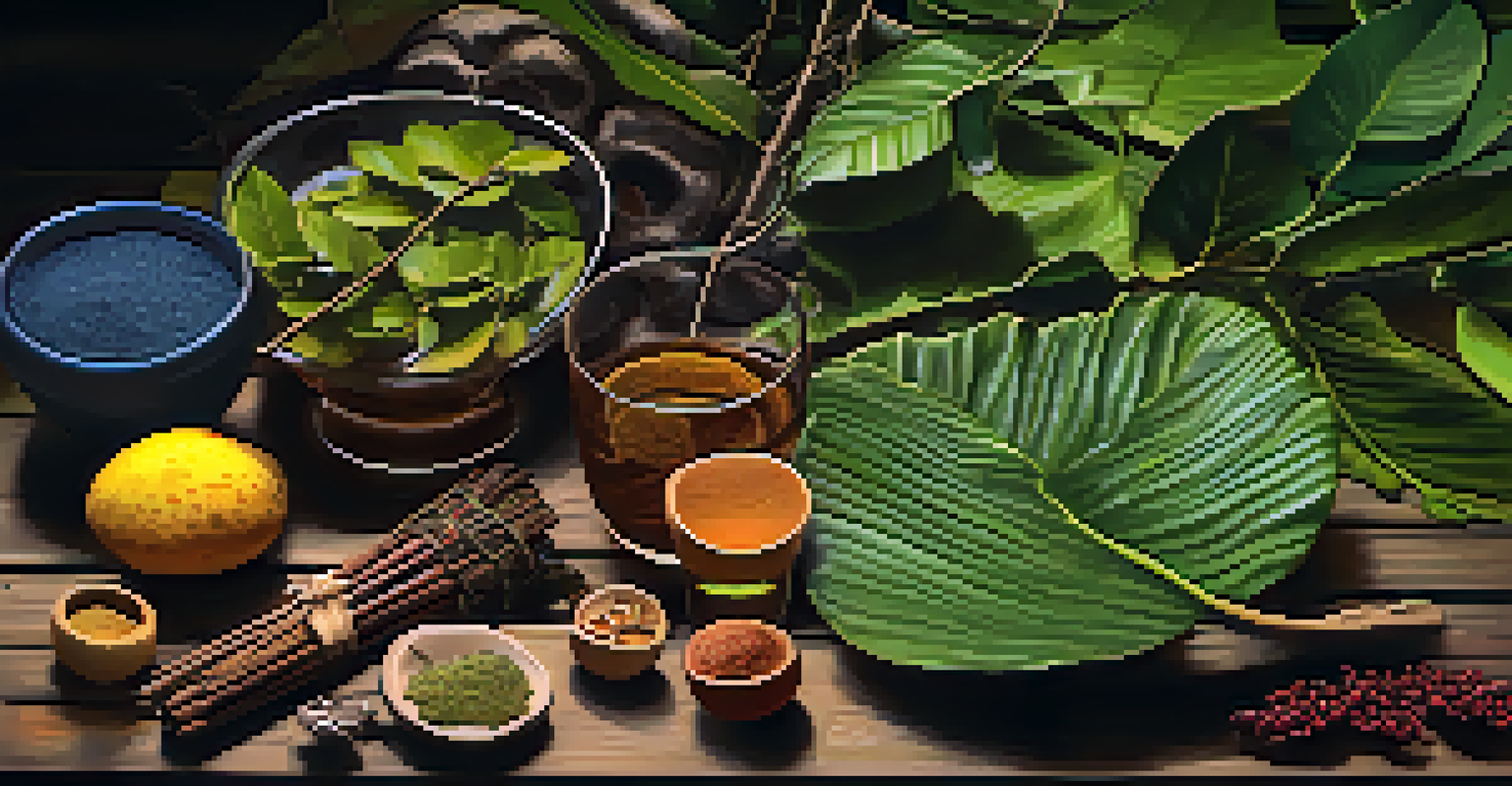Cultural Significance of Ayahuasca in Community Building

Understanding Ayahuasca and Its Origins
Ayahuasca is a traditional Amazonian brew made from the Banisteriopsis caapi vine and other plants. It has been used for centuries by indigenous tribes for spiritual and healing purposes. Understanding its origins is crucial to appreciating its role in community building.
The experience of Ayahuasca is deeply personal; it can help you heal and grow, but it also connects you to others in a profound way.
The brew is known for its psychoactive properties, often leading to profound spiritual experiences. These experiences can foster a sense of interconnectedness among participants. It’s this connection that serves as a foundation for community bonds.
By exploring the roots of Ayahuasca, we learn how it is not just a substance but a cultural phenomenon that encourages collective healing and understanding. This shared experience is what often brings communities closer together.
Ayahuasca Ceremonies: A Shared Experience
Ayahuasca ceremonies are typically conducted in a communal setting, led by a shaman or experienced guide. Participants come together, often sharing their intentions and past experiences, which lays the groundwork for trust and collaboration. This shared vulnerability is essential for community building.

During the ceremony, individuals often undergo personal transformations while being surrounded by supportive peers. This collective journey not only deepens personal insights but also reinforces the bonds among participants. It’s like a spiritual team-building exercise.
Ayahuasca's Role in Community Healing
The collective healing experiences facilitated by Ayahuasca ceremonies promote empathy and strengthen community bonds.
As participants support each other through their experiences, they cultivate empathy and understanding, both vital ingredients for a strong community. These ceremonies become more than just personal journeys; they transform into communal rites of passage.
Cultural Practices and Rituals Surrounding Ayahuasca
The rituals surrounding Ayahuasca, such as drumming, singing, and storytelling, play a significant role in enhancing community ties. These practices create a rich tapestry of shared culture, making participants feel more connected to their roots and each other.
Healing doesn't just happen in isolation; it ripples through the community, creating bonds and resilience.
Rituals often serve as a form of collective memory, where stories of ancestors and cultural heritage are passed down. This shared knowledge helps to reinforce community identity and continuity, especially in a world where such connections can sometimes feel fragmented.
By engaging in these cultural practices, participants not only honor their history but also solidify their present relationships. This fosters a sense of belonging that is crucial for any thriving community.
Healing and Its Role in Community Resilience
Ayahuasca is often sought for its therapeutic effects, addressing trauma and emotional pain. When individuals heal, they contribute to a healthier community. This collective healing can lead to resilience in the face of challenges, allowing communities to thrive together.
As people confront their inner struggles, they often find support from others who are experiencing similar journeys. This solidarity creates a sense of unity that can be incredibly empowering, allowing communities to overcome shared adversities.
Cultural Practices Foster Connection
Rituals surrounding Ayahuasca enhance shared culture and reinforce community identity among participants.
The healing power of Ayahuasca thus extends beyond the individual. When one person heals, it ripples through the community, encouraging others to seek their own paths to wellness. This interconnectedness is a cornerstone of community strength.
The Role of Elders in Ayahuasca Communities
In many Ayahuasca traditions, elders play a pivotal role in guiding ceremonies and imparting wisdom. They serve as cultural custodians, ensuring that practices are passed down through generations. Their presence provides stability and continuity within the community.
Elders often share their own experiences with Ayahuasca, offering insights that can help younger generations navigate their journeys. This mentorship fosters relationships built on respect and understanding, essential for community cohesion.
By integrating the knowledge and experiences of elders, communities not only honor their heritage but also strengthen their collective identity. This intergenerational bond is vital for the sustainability of community dynamics.
Challenges and Controversies Surrounding Ayahuasca Use
While Ayahuasca has many benefits, its use is not without challenges and controversies. Issues such as cultural appropriation and the commercialization of ceremonies can create tension within communities. It's essential to navigate these challenges thoughtfully.
Some communities worry that outsiders may exploit their traditions for profit, leading to a dilution of cultural practices. This concern emphasizes the need for responsible engagement with Ayahuasca, respecting its origins and significance.
Elders Guide Community Traditions
Elders play a crucial role in preserving Ayahuasca traditions, providing wisdom that strengthens intergenerational ties.
Addressing these challenges requires open dialogue within and between communities. By fostering conversations about ethics and respect, communities can work together to protect their traditions while still welcoming those who seek authentic experiences.
The Future of Ayahuasca in Community Building
As interest in Ayahuasca grows globally, its role in community building is likely to evolve. This presents an opportunity to create new connections while honoring traditional practices. The challenge will be to balance the preservation of cultural integrity with the inclusion of broader audiences.
Future gatherings may see a blend of tradition and innovation, where new participants contribute their perspectives while learning from established practices. This fusion can lead to richer, more diverse communities that embrace the essence of Ayahuasca.

Ultimately, the future of Ayahuasca in community building hinges on mutual respect and understanding. By fostering an environment where all voices are heard, communities can thrive and grow together, rooted in shared experiences and collective healing.